Gens Una Sumus!
Newsletter #903
Jan 31, 2020
By Abel Talamantez
Table of Contents
- Max Wilkerson Memorial TNM
- Botvinik/Falconer Award
- Monday Night Rapid Report
- Chernev Memorial Report
- Sadhana Arivoli
- FM Paul Whitehead's Column
- Tony's Teaser
- Scholastic Chess in 2020
- GM Nick de Firmian's Column
- TNM Games
- Submit your piece or feedback
2020 Max Wilkerson Memorial TNM Round 4 Nullified, Will Replay Round Next Week After Electrical Fire Evacuates Institute
We often like to think that we are on fire with our live broadcast and the large turnout for our Tuesday Night Marathon games, but this week everything took a literal turn as the smell of something burning could be detected out in the hallways on the 4th floor. Though the smell had not reached inside the chess room, it was getting stronger each minute. Leaving nothing to chance, we decided to halt the games and evacuate the 4th floor while the fire department was on its way. At the time, 27 games had completed, and 20 were still in progress, including 9 of the 10 broadcast boards.
Once it was known that it was an electrical fire in the library on the 3rd floor (with damage only to the lighting), we thought it best to have players come back inside rather than wait on the street late at night. Five minutes later, the fire department recommended a full evacuation. We then called a halt to play for the evening.
We thought it would be interesting for readers to know how we proceeded from this, as there have been very few instances like this in tournament play, and we received MANY inquiries from players on what would happen and how it would be determined. Here goes:
We knew that the completed games would have to count for rating, as they were games that started and finished. But really that was the only thing that felt certain. We had our ideas of what we thought we should do, and we decided to reconcile those ideas with IA Carol Jarecki, who has organized and served as Arbiter in many world class events, Boyd Reed, Director of Events at U.S. Chess, and Christopher Bird, the newly hired FIDE Events Manager for U.S. Chess. They were very engaged over the first 24 hours and Carol responded to us after conferring with her colleagues, offering three different options we could do. Those were:
A. Adjudicate the remaining games (have a GM determine the outcome). You usually use two such players in the presence of an Arbiter, while keeping the names of the players anonymous.
B. Replay the game(s) that remained undecided at the time of the halt. Since we took pictures of the positions of the unfinished games and clock times and had most scoresheets, we would resume from the current position.
C. Rate the games that have completed as an extra rated game outside of the tournament, and void the unfinished games of the round.
We had discussed B and C, but thought Option A would be too controversial. We also thought it would be disruptive to the event as a whole to use one week to complete unfinished games while the other half of the field stayed at home or played extra games. In order to maintain uniformity, we elected to use option C) to void the unfinished games of the round, and rate the finished games in a separate section, essentially re-start Round 4, so everyone can come back and play together the following week. We also allowed players to offer draws to their opponents, and we would facilitate the offer via email. Because of bye requests, the potential for some pairings to be different from the previous week remains, though there will more likely than not be similar pairings for the new round 4. Since we are re-starting the round on February 4th, we will have the 7th round played on Tuesday February 25th, which normally would have been an off week.
We sent an email to all the participants once we made our decision, and thankfully it was universally supported. We knew that some players were going to be on the short end, as they had built advantages in their games, but moving forward in this way brings about a conclusion to the round where everyone can reengage together, rather than continue separately. We are a club and community, very different from a major event like the National Open, made up of players from diverse backgrounds. We are one community together, and we felt that nullifying the round for unfinished games and doing the round over next week would be the best fit for our club. Given that next Tuesday is going to be a very special evening because of the award ceremony for John Donaldson and Christopher Yoo, it made this decision all the more viable.
I want to thank the best team in chess: Judit Sztaray who worked hard in helping evacuate the crowd, communicating with them outside and with the fire department and for helping take pictures of all unfinished games; Juan Cendejas for also taking pictures and for helping Judit in communication; and Paul Whitehead and Jim Eade for calling the fire department and offering support inside the building as we were escorting people out. Thank you also to Marc Lenahan, running the broadcast, who informed viewers in the chat what was happening as viewers at the end of the broadcast could see the evacuation of the room. They all rallied around to help bring about an orderly and peaceful evacuation, and maintained calm throughout. We are all truly lucky to have this team at Mechanics', and everyone showed poise and leadership amidst potential chaos.
I want to personally thank all our players also who have greatly voiced their support. The club does not have the same spirit without their participation and contributions, and we hope as staff we live up to the history and tradition that is the Mechanics' Institute Chess Club, one of the world's great clubs.
The most important takeaway is we all come back to play another day, to enjoy the club together and with each other. See you all next week!
Abel Talamantez
Chess Director, Mechanics' Institute
It is never too late to join the marathon! To register, please email us: [email protected]
To watch the replay of the round, including the final evacuation at the very end, please follow this link here
For a full list of standings and results from the round, click here
2019 FIDE Botvinik Award and 2019 Neil Falconer Award Presentation Tuesday Feb 4th!!
We will have a truly special evening of chess this Tuesday February 4th, 2020, as we will be honoring two important achievements, one for longevity and commitment to service in training and coaching, the other for the future of American chess in the beginning stages of great things to come.
We will present the 2019 FIDE Botvinik Award trophy to IM John Donaldson, legendary Chess Director of the Mechanics' Institute and Captain of the U.S. Olympiad team. After that, we will present the 2019 Neil Falconer award to this years recepient IM Christopher Yoo! The Falconer award is given to the highest USCF rated player under 18 years old, which Christopher earned this year (at 13 years old) with a rating of 2531. He will be given a check for $2531 on that Tuesday. We plan to start the award presentations at 6pm, right before the start of round 5 of the TNM.
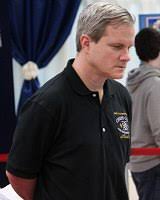
IM John Donaldson
Christopher Yoo has also agreed to join the broadcast as guest commentator that evening along with FM Paul Whitehead and FM Jim Eade, who will also be in attendance. It will be a terrific evening, and surely an entertaining broadcast.
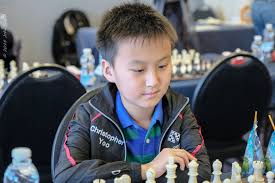
IM Christopher Yoo
Neil Falconer was a former Mechanics' Institute Trustee, Board President, and was influential in preserving the chess room as a part of the Mechanics' Institute. He was profoundly influential in promoting and supporting chess at the Mechanics' Institute, and he started this award in 1999, benefitting many top players of the future, including Sam Shankland, Daniel Naroditsky and many others. To read a great article about Neil Falconer in Chess Life Online, please click on this link
To read an article on Donaldson's Botvinik award in US Chess Online, please follow this link
Join us that evening to celebrate their achievements, either live at the club or online through our broadcast here
January 2020 Monday Night Rapid Report
The first Monday night Rapid of 2020 got off to an amazing start, as 26 players competed for MI Rapid glory. Mechanics' regular FM Kyron Griffith took clear first with 3.5/4 in the top section, besting IM Teddy Coleman, Daniel Smith, and Carlos Davila, who tied for 2nd place with 3/4. In the under 1600 section, Daniel Dandurand captured 1st place with a perfect 4/4, while Cesar Tamondong and Brian fong tied for 2nd with 3/4.
The Monday Night Rapids (MNR) are the last Monday of the month, and are a 4-round G/15 +2 tournament that is FIDE rapid rated and USCF quick rated. Please join us for the next one on February 24th, info can be found here
For a ful list of results for this event, please click here
2020 Irving Chernev Memorial Report
The 1st Irving Chernev Memorial tournament concluded with 34 players, playing a smooth 3-round G/75 one day event. In the top section, South Bay expert Archit Dasika made his forst visit to MI a good one, takin clear 1st place with 3/3. Tied for 2nd place were FM Kyron Griffith and Siddharth Arutla, who turned in a great performance, with 2.5/3.
In the under 1800 section, Neil Bhaduri finished strong and took sole 1st place with a perfect 3/3 after his fonal round victory over AAdith Muthukumar. Tied for 2nd place in the section were Mateo Hanson and Alejandro Canales with 2.5/3.

Simona Nayburg ponders her next move

FM Kyron Griffith plays black on board 1 against Adam Mercado. He took a bye for the final round, opening the door for Archit Dasika, playing black on board 2.
Thanks to Michael Da Cruz for taking this unsolicited photo. I said I'd use it, so here it is
For a full list of the results from this event, please click here
Thanks to all the players who participated!
Local Player Sadhana Arivoli Wins USCF 2019 Junior Grand Prix
Local Player Sadhana Arivoli Wins USCF 2019 Junior Grand Prix with 10,850 points. This is a great accomplishment, and was a competition for kids all over the nation. Gran prix points are earned by playing in USCF events of at least 4 rounds and points are earned by winning or drawing against higher rated players. She will recieve an award at the 2020 U.S. Open this year in Missouri. she recently played a tournament at the Mechanics' Institute and participated in one of our camps. She caught my attention at last year's U.S. Amateur Team West when she scored a draw against an expert 2000+ player while she was 1100! Congratulations to her for her hard work and for the strong family support she receives!

Sadhana Arivoli in knit cap playing the Donaldson Championship at Mechanics' in December
FM Paul Whitehead's Column
Famous Chess Games You Should Know
The “Miniature” - World Champion Examples, Part 3.
By FM Paul Whitehead
Like their predecessors, our modern-day champions are also masters of the short-game:
Robert Byrne – Robert Fischer, U.S. Ch. 1963/64.

21…Qd7!! forced Byrne’s resignation, and remains one of the most stunning deciding moves in chess.
Echoes of this can be heard in Giri – Carlsen, Croatia 2019, given below - in which it seems hardly a shot is fired! To win a game in under 25 moves against a peer (and their computer) nowadays is almost beyond belief, yet it still happens.
My personal favorite of the games below is Kasparov’s crushing take-down of Ljubojevic in 1983. This game seems to say, in no uncertain terms:
“I am the World Champion - hear me roar!”
(1) Robert James Fischer - Jorge Alberto Rubinetti [B87]
Palma de Mallorca Interzonal Palma de Mallorca ESP, 1970
This game was played in the famous 20 game winning streak in the long run-up to the match with Spassky in 1972. 1.e4 c5 2.Nf3 d6 3.d4 cxd4 4.Nxd4 Nf6 5.Nc3 e6
 |
 |
 |
 |
 |
 |
 |
(2) Anatoly Karpov - Vlastimil Hort [B17]
Bugojno Bugojno YUG, 1978
Hort was a strong grandmaster, but didn't always play the opening very well. Karpov is in top form, and in this sharp attacking game cashes the Czech straight off the board. 1.e4 c6 2.d4 d5 3.Nd2 dxe4 4.Nxe4 Nd7
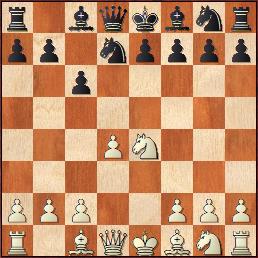 |
 |
 |
 |
 |
 |
(3) Ljubomir Ljubojevic - Garry Kasparov [A07]
Niksic Niksic YUG, 1983
Ljubomir Ljubojevic was the 3rd ranked player in the world when this game was played, behind Karpov and Kasparov. This game highlights the gulf that separated the 2 K's from the rest. 1.e4 c5 2.Nf3 e6 3.d3 White opts out of Open Sicilians with 3.d4, choosing the King's Indian Reversed set-up. 3...Nc6 4.g3 d5 5.Nbd2 g6
 |
 |
 |
 |
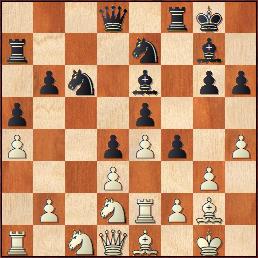 |
 |
 |
(4) Vladimir Kramnik (2770) - Garry Kasparov (2849) [E53]
Kasparov - Kramnik Classical World Cham London ENG, 2000
Vladimir Kramnik took the title from Kasparov in this match. This short gem may have been partly cooked at home, but white's precise play stands out. To beat Kasparov in a mere 25 moves was quite something! 1.d4 Nf6 2.c4 e6 3.Nc3 Bb4 4.e3 0-0 5.Bd3
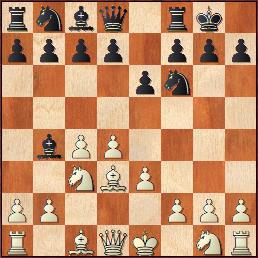 |
 |
 |
 |
 |
 |
 |
 |
(5) Viswanathan Anand - Joel Lautier [B01]
Biel Credit Suisse Biel SUI, 1997
"Vishy" is a great attacking player, and I enjoy seeing the Center Counter Defense destroyed. 1.e4 d5 2.exd5 Qxd5 3.Nc3 Qa5 4.d4 Nf6 5.Nf3 c6
 |
 |
 |
 |
 |
 |
 |
 |
 |
 |
(6) Anish Giri - Magnus Carlsen [B30]
GCT Croatia Zagreb CRO, 2019
An understated masterpiece from the current World Champion. 1.e4 c5 2.Nf3 Nc6 3.Bb5 e6 4.Bxc6 bxc6 5.d3
 |
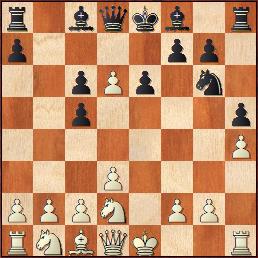 |
 |
 |
 |
 |
White is surprisingly helpless in the final position, and I urge the reader to work out some lines on their own. 0-1
Tony's Teasers
Last week's problem:
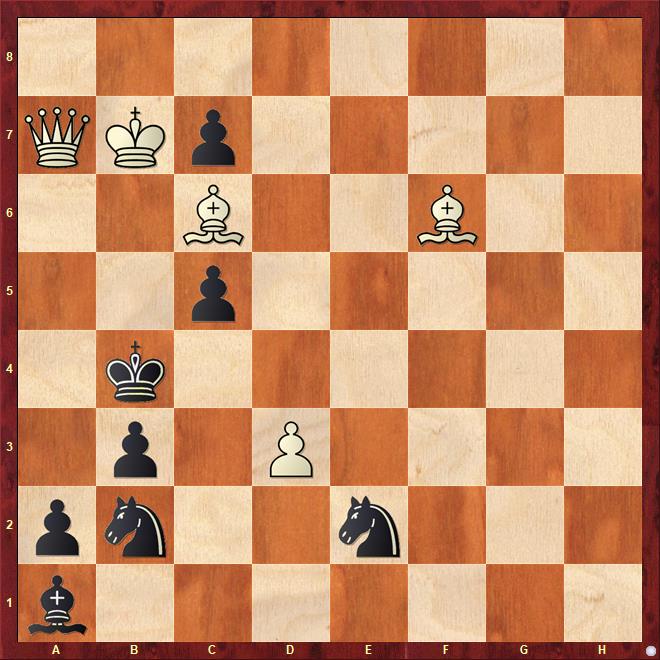
White to move and mate in 3, B. Harley 1932
Solution: 1. Bg7!! c4 2. Qa3+ Kxa3 3. Bf8#
This week's problem:
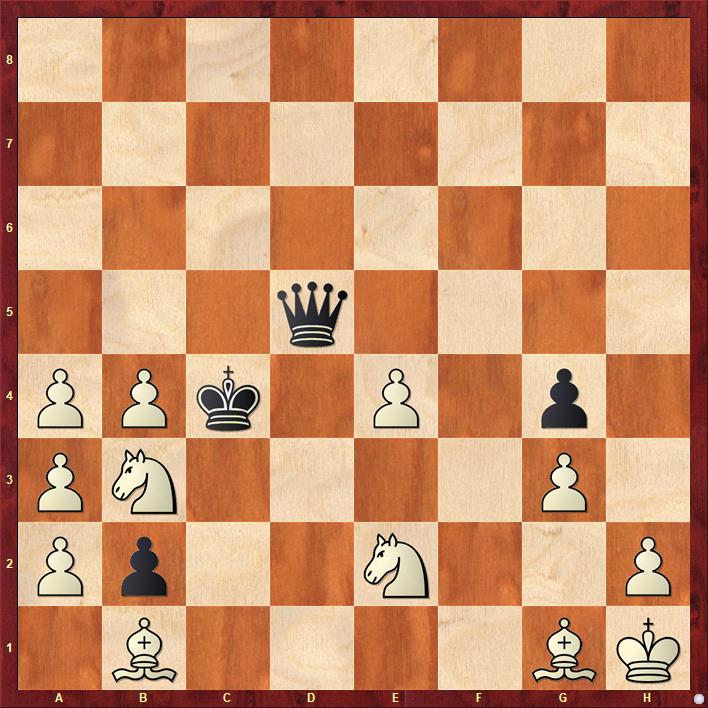
White to move and mate in 3. H. D'O Bernard, 1930

Scholastic Chess
Fun Saturday Scholastic tournament day with an exciting TEAM Twist :)
Save the Dates
- 2020 US Amateur Team West Nationals - Kids Championship
Saturday, February 15, 2020 @ Hyatt Regency Burlingame
Information - Registration
- 2020 San Francisco Scholastic Championship
Saturday, March 28, 2020 @ Golden Gate Park
Information - Registration - Flyer
GM Nick de Firmian's Column
Practical Openings 2: The 2. c3 Sicilian
Of all the complicated openings with long variations, there is nothing worse than the Sicilian Defense. Bobby Fischer and Garry Kasparov would analyze to 30 moves deep in variations of labyrinth complexity. Hundreds of grandmasters have followed their lead and become experts on these razor sharp, intricate variations. The fear of falling into your opponents opening preparation and losing without them ever making an original move is a very real nightmare in the Sicilian. Therefor a lot of tournament players started to play the practical move, 2. c3 to avoid this problem. The move is very logical as it attempts to take full control of the center with 3. d4. While this may seem rather direct and crude (as the Ponziani Opening), there is enough bite to the strategy to pose the second player with problems.
Some opponents will think – what a silly, wimpy opening. So, let them think that! They may be purists that prefer a different combative style of the old champions, yet they have to deal with your move, your opening plan. That they get frustrated is just a practical advantage for you. Play your practical opening and let them complain!
(1) White - Black [B22]
2. c3 Sicilian
1.e4 c5 2.c3 Diagram
 |
The 2. c3 Sicilian is a remedy for all the complexities that can arise from the terribly complex Najdorf, Dragon, Shevishnikiov and a dozen other variations of the open Sicilian. Your opponent probably has studied his/her favorite vartiation in depth, so you side step all that with this second move. 2...d5 Diagram
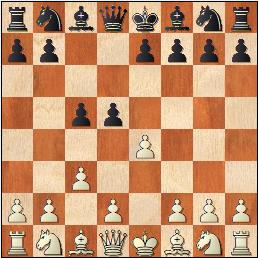 |
The main line and one of two extremely logical moves. Black seeks to immediately battle in the center and makes use of the point that White cannot place a knight on c3 right now. 3.exd5 Qxd5 4.d4 Staking out the center. White is quite willing to take on an isolated pawn if he/she gets quick development. If Black captures now on d4, White will recapture with the pawn and have c3 open for the knight. 4...Nf6 5.Nf3 [5.dxc5 Qxd1+ 6.Kxd1 puts White's king in the center and allows Black the initiative at the cost of a pawn.] 5...e6 [5...Bg4 6.Be2 e6 7.h3 Bh5 8.0-0 Nc6 9.Be3 cxd4 10.cxd4 is a very reasonalble altenative, investgated in our illustrated game Deep Blue - Kasparov (game #4).] 6.Be2 Nc6 7.0-0 Diagram
 |
7...Be7 [7...cxd4 8.cxd4 Bb4 9.a3 Ba5 a la Kasparov, though the simple 9... Be7 is also reasonalbe. In both cases Black has a reasonable position, though White is a tad better.] 8.c4!? White could also continue with 8. Be3 in straightforward fashion. The text move has merit thought. 8...Qd6 9.dxc5 Qxd1 10.Rxd1 Bxc5 11.Nc3 0-0 12.a3 Diagram
 |
White has the more comfortable position. Black has no bif worries yet has a bit of work to do to get full eqaulity. *
(2) White - Black [B22]
2. c3 Sicilian
1.e4 c5 2.c3 Nf6 Diagram
 |
This is the second most popular reply to the 2. c3 Sicilian. Both 2...d5 and 2...Nf6 attack the center and limit White's replies. 2...Nf6 usually leads to a positon like an Alekhine Defense, but slightly improved hances for Black as the advance of both sides c-pawns leave more squares for the black knight. 3.e5 Nd5 4.d4 cxd4 5.cxd4 The most straightforward reply. [White could also try 5.Qxd4 e6 6.Nf3 Nc6 7.Qe4 d6 8.Nbd2 dxe5 9.Nxe5 Nxe5 10.Qxe5 Qd6 as played by Fischer (as Black), with an equal game,; Or 5.Nf3 d6! 6.cxd4 transposing into the main line.] 5...d6 6.Nf3 Nc6 Diagram
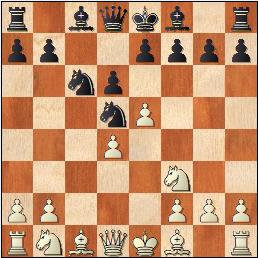 |
7.Bc4 [It is not good to enter the endgame that arises after the developing move 7.Nc3 dxe5 8.dxe5 Nxc3 9.Qxd8+ Nxd8 10.bxc3 Bd7] 7...e6 [Some players choose 7...Nb6 8.Bb5 dxe5 9.Nxe5 Bd7 10.Bxc6 Bxc6 11.Nxc6 bxc6 12.0-0 e6 13.Qg4 This alternative play leaves White the isolated d-pawn but Black has yet to castle.] 8.0-0 Be7 9.Qe2 0-0 10.Nc3 Nxc3 11.bxc3 dxe5 12.dxe5 Diagram
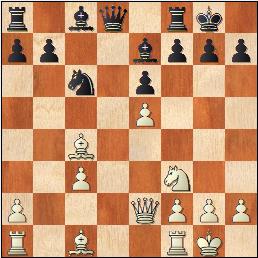 |
White has worse pawn structure yet has attacking chances because of the advanced e pawn and good development. 12...Bd7 [12...b6?! 13.Qe4 Bb7 14.Bd3 is very active for White] 13.Qe4 Na5 14.Bd3 g6 15.Bh6 Bc6 This complicated position has chances for both sides. *
(3) White - Black [B22]
30.01.2020
1.e4 c5 2.c3 e6 [2...g6 Diagram
 |
is an alternative yet it leaves White with the stronger center after 3.d4 cxd4 4.cxd4 d6 5.Nc3 Bg7 6.Nf3 Bg4 7.Be3] 3.d4 d5 4.exd5 [4.e5 would transpose into the Advance Variation of the French Defense. That could be an accomplishment for a player against a Sicilian expert.] 4...exd5 5.Nf3 Nc6 6.Bb5 Bd6 Diagram
 |
7.dxc5 Bxc5 8.0-0 Nge7 9.Nbd2 0-0 10.Nb3 Bb6 Black could maintain an equal game with the active move 11...Nf5, yet White has an easier game to play. 11.Re1 Diagram
 |
*
(4) Deep Blue - Kasparov,Garry [B22]
1996
1.e4 c5 2.c3 d5 3.exd5 Qxd5 4.d4 Nf6 5.Nf3 Bg4 6.Be2 e6 7.h3 Bh5 8.0-0 Nc6 9.Be3 cxd4 10.cxd4 Diagram
 |
10...Bb4 11.a3 Ba5 12.Nc3 Qd6 13.Nb5 Qe7 14.Ne5 Bxe2 15.Qxe2 0-0 16.Rac1 Rac8 [16...a6 17.Nxc6 bxc6 18.Nc3 h6 Is fairly equal, but still a little more comfortable for White after say 19. Na4] 17.Bg5 Bb6?! [17...Rfd8 18.Bxf6 gxf6 19.Nc4 a6 20.Nxa5 Nxa5 21.Nc3 Kh8 22.d5 Nc4 23.Rfd1 Ne5 is only slightly better for White.] 18.Bxf6 gxf6 19.Nc4! Rfd8 20.Nxb6 axb6 21.Rfd1 f5 22.Qe3 Qf6 Diagram
 |
23.d5! This aggressive move leads to a change of pawn structure in White's favor. 23...Rxd5 24.Rxd5 exd5 25.b3 Kh8 [Not 25...d4? 26.Nxd4] 26.Qxb6 Rg8 27.Qc5 d4? Black's position looks very active, but he has weakenesses. 27...f4 would keep more chances for Black. 28.Nd6! f4 Kasparov is attacking, but now comes a brave (and greedy) move that only a cold blooded human or a computer would make. Black is massing his pieces on the kingside yet there is a loose pawn on the queenside. 29.Nxb7! Diagram
 |
29...Ne5 30.Qd5 f3 Looks very threatening. 31.g3 Nd3?! All the activity is calmly countered by Deep Blue. Good advice is hard to find, but 31... d3 is objectively better. Most humans would be terrified by the Black onslaught, but Deep Blue has no emotions. 32.Rc7 Re8? 33.Nd6! Re1+ 34.Kh2 Nxf2 Diagram
 |
It seems Black has unstoppable check mate even if Black gives up the queen. There is a solution however. 35.Nxf7+ Kg7 [35...Qxf7 36.Qd8+ Kg7 37.Rxf7+ Kxf7 38.Qd5+ Ke7 39.Qxf3 would settle matters, as 39...Rh1+ 40.Kg2 is over.] Black threatens mate, but White gets through first. 36.Ng5+ Kh6 37.Rxh7+ Diagram
 |
White gets there first. Kasparov resigned. This was his only defeat in the 1996b match. 1-0
(5) Stripunsky,Alexander (2570) - Robson,Ray (2620) [B22]
USA-ch Saint Louis, 2013
1.e4 c5 2.c3 Nf6 3.e5 Nd5 4.Nf3 Nc6 5.Bc4 Nb6 6.Bb3 d5 Diagram
 |
7.exd6 c4 8.Bc2 e5 9.d4 cxd3 10.Qxd3 Qxd6 11.0-0 Bg4 [Safer would be 11...Qxd3 12.Bxd3 with few troubles for Black. Robson chooses a more complicated game.] 12.Qe2 Be7 13.Nbd2 0-0 14.h3 Bh5 15.Ne4 Qc7 16.Ng3 Bg6 17.Bxg6 hxg6 The postion is equal, with chances for both sides. Players who simply want to get a game without opening problems would be happy with both Black and White's position. 18.Re1 Rad8 19.Bg5 Rfe8 20.Rad1 f5 21.Rxd8 Bxd8 22.h4 e4 23.h5! Be7? Diagram
 |
White has a surprising rejoiner to take the advantage. 24.hxg6! Qd7 [Not 24...exf3? 25.Qe6+ Kh8 26.Qxf5 Qd7 27.Qe4 with a quick decision] 25.Nxe4! Bxg5 26.Nfxg5 fxe4 27.Qh5 Qd5 28.Qh7+ Kf8 29.Qh8+ Qg8 30.Qh4 [30.Rxe4! Qxh8 31.Nh7+! would have been a quick win] 30...Re7 31.Rd1 Ke8 32.Nxe4 Nc8 33.Qh3 Rc7 34.Qh7 N6e7 35.Ng5 Nonetheless Black has too much to deal with. 35...Rc6 36.Nf7 Rxg6 37.Rd8+ Kxf7 38.Rxg8 Nxg8 39.Qh5 Nd6 40.c4 Nf6 41.Qc5 Nd7 42.Qxa7 Nxc4 43.Qxb7 Rd6 44.Qf3+ Nf6 45.a4 Diagram
 |
The queen and pawns are too much for the rook and two knights. The finish takes a while, but is not in doubt. 45...Re6 46.Qc3 Ne5 47.a5 Rc6 48.Qd2 Ke6 49.b4 Ne4 50.Qe3 Kd5 51.f3 Ng3 52.Qb3+ Kd4 53.Qb2+ Kd5 54.b5 Rc1+ 55.Kh2 Nf1+ 56.Kh3 Rc4 57.b6 g5 58.Qb5+ Kd6 59.g3 Nxf3 60.Kg2 g4 61.Kxf1 Rc1+ 62.Kf2 Rc2+ 63.Ke3 Rc3+ 64.Kf4 Rc8 65.Qd3+ Ke7 66.Qe4+ Kd6 67.Qg6+ Ke7 68.Qg7+ 1-0
2020 Wilkerson Memorial TNM Games Round 4
Annotations by GM Nick de Firmian
Due to the interruption of the round and subsequent voiding of the unfinished games of TNM round 4 on January 28th, we will publish the new 4th round games next week when round 4 re-starts on February 4th. Thank you for your patience and understanding.
Submit your piece or feedback
We would welcome any feedback, articles or "Letter to the Editor" piece. Submit yours today through this Google Form:
You can browse through our archived newsletters using the "next" and "previous buttons".
Want to save this newsletter for reading at a later time? Click here to learn how.
Want to be notified when the next newsletter is published? Join Our Email List →
